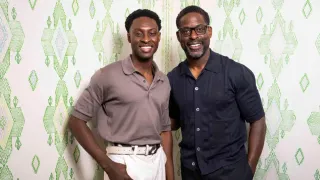September 30, 2021
Bruce LaBruce Talks Twincest, Religion, Politics, and 'Saint-Narcisse'
Kilian Melloy READ TIME: 11 MIN.
Fans of out Canadian filmmaker Bruce LaBruce will know what to expect from his newest movie, "Saint-Narcisse," a 1970s-set drama about twins separated at birth who must unravel dangerous family secrets in order to find each other, understand who they are, and survive the perilous situations they've been thrust into.
Both twins are played by actor and stuntman Félix-Antoine Duval, who is able to transform from the scruffy, aimless, slightly devilish Dominic into the cloistered, melancholy, and repressed Daniel, who has spent his entire life sequestered in a reclusive monastic order under the strict supervision – and the sexually abusive attentions – of the sinister Father Andrew, a deluded zealot with a St. Sebastian fetish. Even as he's figuring out how to help his brother, Dominic is forging fresh ties with their mother Beatrice, whom he's always believed died in childbirth. But Beatrice is regarded by the fearful townsfolk as a witch, a reputation enhanced by the presence of a female "companion" who never seems to age.
If this sounds like the plot of a campy and somewhat gothic psycho-sexual thriller... well, that's exactly what it is. LaBruce has never hesitated to blend sex, politics, religion, and camp into wild cinematic experiences that run an outrageously colorful gamut, from the explicit critique of the political left that was "The Raspberry Reich" to the queer implications of zombiehood in "Otto: or, up with Dead People," to 2018's "The Misandrists," a blend of religious mania and revolution (sexual and otherwise).
Naturally, "Saint-Narcisse" enjoys LaBruce's unique brand of humor right along with the other hallmarks of his inimitable style. The director points to a favorite scene in which the twins, having finally found each other, engage in lakeside sex. Afterwards, as they discuss Daniel's dilemma – Father Andrew is both his father figure and a sexual abuser – Dominic grows angry. "It's not right!" he exclaims. "And what we just did is?" Daniel rejoins. Daniel replies, in all sincerity: "That's different. We're family."
"I mean, it's a one-liner but he delivers it not as a joke," LaBruce explains. "That, for me, is what makes it work."
Though not as sexually explicit as some of LaBruce's work (he also works in porn), the film offers plenty of naturalistic male nudity. But that doesn't mean it's any less hardcore in its social messaging and even in its philosophical musings; as the filmmaker tells EDGE, the movie is a full-frontal inquiry into a porn subgenre known as "twincest," with all the mythic and erotic resonances that entails.
EDGE: When we spoke a couple years ago about your film "The Misandrists," you mentioned having "Saint-Narcisse" in the works. And now here we are! This film feels to me like an extension of "The Misandrists," thematically speaking, with its examination of religion and sexuality.
Bruce LaBruce: Yeah, it's something I've been exploring for a while now. [In 2012] I had a photography show in Madrid called "Obscenity," exploring the intersection of religious and sexual ecstasy. I shot like some big pop stars, like Alaska and Rossy De Palma, and some other well-known actors and performers in Spain. I posed them like saints, and I used the Ostia, the holy wafer, as a kind of symbol of fetish – they would wear the holy wafer on their nipples or their genitals, or over their eyes or their mouth – so it was erotic, but also as a symbol of censorship.
It was a huge scandal in Spain, and the mayor tried to shut down the show. There were protesters outside the gallery with placards, blasting Christian rock music. And then, the day after the opening, which was packed, somebody threw an explosive device through the front window of the gallery. It didn't go off, but then the police were involved, and it was really a national scandal. That kind of whet my appetite for this kind of exploration, because I thought, "This is really hot button; this is something that really gets to the nerve, to the bone."
I'm not Catholic, and I didn't even really consider it that blasphemous, to be honest because the, the whole history of Catholic saints is full of sexual fetish and self-abnegation and, you know, self-flagellation, and all those kinds of things. It just seems like it's kind of built into the Catholic mythology; there is a sexual component to that kind of religiosity, and for me, also, there's a religious aspect to fetishes. Like, even something as simple as a foot fetish – it has a reverence for the object of desire, it's a kind of devotion. When [religion and fetish] coincide, I find it really interesting, so I guess that was maybe the kernel of what I'm doing in "Saint-Narcisse." I'm making a series of films about different kinds of modern-day saints.
EDGE: It feels like "Saint-Narcisse" is an experiment in all the ways you can play opposites, and contrasts, off of each other.
Bruce LaBruce: Yeah, I mean, the whole film is set up very specifically to contrast two aspects of sexuality, of social and religious belief. So, you have the Earth Mother of Beatrice, who's kind of a hippie; she's obviously anti-organized religion; she's Wiccan, probably; she is in touch with nature; she smokes pot.
And then you have Father Andrew, who is the strict authoritarian. He lives in a very sterile environment; he's, he's probably taking.. I'm not sure what drug he's taking; I never really thought about it...
[Laughter]
He's taking a Hollywood narcotic. And they're both in quasi-incestuous relationships; the mother is having a relationship with her dead lover's daughter, who looks exactly like her lover, and Father Andrew is having sex with this boy [to whom] he's the father figure. You could say that they're both exploitative relationships, although Beatrice's is much more within the realm of social acceptability and it's actually a loving, caring relationship, whereas with Father Andrew and that sterile, strict religious kind cult, it's a very exploitative relationship, so those two worlds are contrasted.
And then there are the twins, who are having a twincestuous relationship, which is also kind of the most acceptable form of incest. I mean, because people can kind of understand the idea that if you had an exact replica of yourself when you're growing up, there might be some sort of very close physical, and maybe sometimes even sexual, kind of contact between them.
EDGE: My husband's an identical twin and he always tells me that "singlets" have a twin porn fetish. Do you find this is true?
Bruce LaBruce: There is a very well-developed sub-genre of porn, twincest. It's real. In fact, the working title of "Saint-Narcisse" was "Twincest."
[Laughter]
And, in fact there's triplet porn. Belami has triplets that do porn together. So, it's a pretty common fetish, and it's a narcissistic fetish for the two people engaged in it. I don't know what the appeal is, except that it's a mild social taboo.
For me there's two types of gay men: Either those who are attracted to someone who's exactly like them, and we see that all the time where there's a gay couple that almost dress identically, they look almost exactly the same; my friends and I call them "twinnies." And then there's ones who want the exact opposite of that. They want someone who couldn't be more different. If they're feminine, they want someone super-masculine; if they're tall, they might want someone short, or whatever. For me, that kind of narcissim is an interesting phenomenon as well, so that plays out in the movie as real twins.
There's also a phenomenon that I read about that, when people who are related closely are separated at birth and have never known each other, when they meet as adults it's not uncommon for there to be a romantic attachment, because they haven't been raised and socialized together – they haven't lived out the traditional family roles, so there's no real prohibition for them, and they see themselves in a narcissistic way in this other person. It's not uncommon for there to be sexual or romantic feelings, and sometimes relationships.
EDGE: There's certainly nothing to complain about when you have two characters who are as beautiful as Félix-Antoine Duval, who plays both Dominic and Daniel.
Bruce LaBruce: I mean, when you're playing Narcissus, you better be reasonably good looking, I would say.
[Laughter]
EDGE: He just seems perfect for this part. He doesn't feel that he's one actor playing two parts; he felt like two people.
Bruce LaBruce: Yeah, that was the challenge of the film, or one of the challenges. The film is an homage to Quebec cinema from the '70s which, incidentally, had themes like incest and family secrets coming back to haunt people, and that kind of thing.
EDGE: There's an undercurrent of the familiar Bruce LaBruce humor and satire all throughout the movie; there are all these funny puns, like a box of laundry detergent that looks like Tide brand, but the word on the box is "Time." Or something as central to the film as Dominic realizing he has a brother... and his brother is a brother, in a monastic order. When Father Andrew warns Dominic that "Curiosity killed the cat," you somehow wrangle a cat to walk across the screen.
Bruce LaBruce: That was a coincidence.
EDGE: I think my favorite is when Daniel flogs himself while looking at an underwear magazine. Plenty of guys might do that... but not literally, with a cat of nine tails!
Bruce LaBruce: I thought people from a certain generation would appreciate that joke because, at least for me, that was one of my sources of porn growing up; the underwear section [of the mail order catalogue].
EDGE: Given that the movie has so much emotional force, and so much dramatic force, it felt like maybe you were reassuring the viewer that, no, this is a Bruce LaBruce movie, with humor and a satirical edge.
Bruce LaBruce: In some ways the movie does have a light touch, and that's something people have told me – that I tend to have a light touch with heavy subjects. The movie overall, I think, does work dramatically; the performances are great. But it still is camp, on a certain level, because the scenario is so convoluted and it's melodramatic. For me, the best camp is played straight, so I didn't have the actors winking at the camera or going over the top. I wanted them to give credible dramatic performances – for example, at the end, when they all end up in this kind of polyamorous family. That's a way to [say], "Look at all this kind of heavy religious everything, like the guilt, and the pain, and the suffering, and everything," and to take the piss out it. Religion imposes it on people, and it really isn't necessary.
EDGE: Although there's a fair amount of nudity in this film, and there's a bit of sex, there's nothing really explicit. Did more explicit sex not feel right for this particular material?
Bruce LaBruce: The intent from the beginning was that it would be more of an indie film that would be more viewable for wider audiences. Originally, I did think of trying to find real twins to play the roles; even if they didn't have actual sex in the film, seeing actual twins on screen kissing and being intimate with each other would be very shocking. But we quickly realized that would be almost impossible to pull off.
But, no, the intention wasn't to be explicit. In fact, it was some of my more recent films, including "The Misandrists," are referencing films from the '70s that are kind of considered softcore porn, sexploitation films. When I make a larger-budgeted film, it's just really [a matter of] when you have more money, and it's financed, gratefully, by Quebec Telefilm and Sodec [a governmental cultural agency], they're not really looking for porn films.
[Laughter]
My early film work was all guerilla filmmaking, it's gonzo, so you can do pretty much whatever you want. But in this context, when I'm making these bigger budget films – it's a union crew and everything – actually making a porn film would be impossible. Even to do explicit sex, I didn't think it was right for this particular film, because it's already taboo enough. For example, I initially thought that I would make the scene where Father Andrew is pushing the arrows into the boy's chest, sort of torturing him like St. Sebastian, I originally intended that to have more gore, with lots of fake blood and stuff – but then I just thought, "It's better to leave it to the imagination," which is quite often the case.
EDGE: Straight people sometimes like to criticize gay people for being narcissistic, but it feels like this movie is also holding up a mirror to straight people and saying, "Oh yeah? Well, you're not anyone to talk."
Bruce LaBruce: For sure! Part of the idea was taking twins as the kernel of the movie, with the script, which I wrote with a great Quebecois script writer [Martin Girard]. My idea was to transpose the Narcissus myth onto the twincest kind of model. And then, because it was set in the '70s, I thought it would be a great opportunity to make a comment on modern narcissism, in the context of what things were like 40, 50 years ago. Within the story, it is bizarre that this guy is constantly taking [Polaroid] pictures of himself and giving them to other people. It's kind of meant to be a precursor of social media. Someone even says, "He only takes pictures of himself. Who does that?" – which is another one-liner, but it's true. I mean, to see someone so self-obsessed in the context of the early '70s seems like bizarre behavior. Of course, he has an underlying reason for doing it, but it does draw attention to the fact that everyone does it now.
Narcissism isn't just about being in love with your yourself, or your own image. Both Beatrice and Father Andrew are narcissists, in a way, because they act on their desires, and sexual desires, without taking into account what kind of emotional effect that might have on those around them. It's a kind of selfishness that they're only concerned about their own pleasure and their own desires.
EDGE: What other projects might you be working on now?
Bruce LaBruce: I have a film in development with a Mexican producer that that I hope to shoot in Mexico. The title of it is "Santo Cabrón," and it's also about a kind of saint. He's a queer cartel member who dresses like a priest; he's actually a cartel meth dealer. The movie has elements of [directors Sam] Peckinpah and [Alejandro] Jodorowsky.
And then I have another one that is stalled, that I'm not sure I can get made. It's a Chilean film about another kind of saint who heals people through sexual congress. "Santo de Obscene," it's called. And then I have other projects that aren't so saint-centric.
[Laughter]
EDGE: I can imagine.
"Saint-Narcisse" is now playing in select theaters.
Kilian Melloy serves as EDGE Media Network's Associate Arts Editor and Staff Contributor. His professional memberships include the National Lesbian & Gay Journalists Association, the Boston Online Film Critics Association, The Gay and Lesbian Entertainment Critics Association, and the Boston Theater Critics Association's Elliot Norton Awards Committee.






